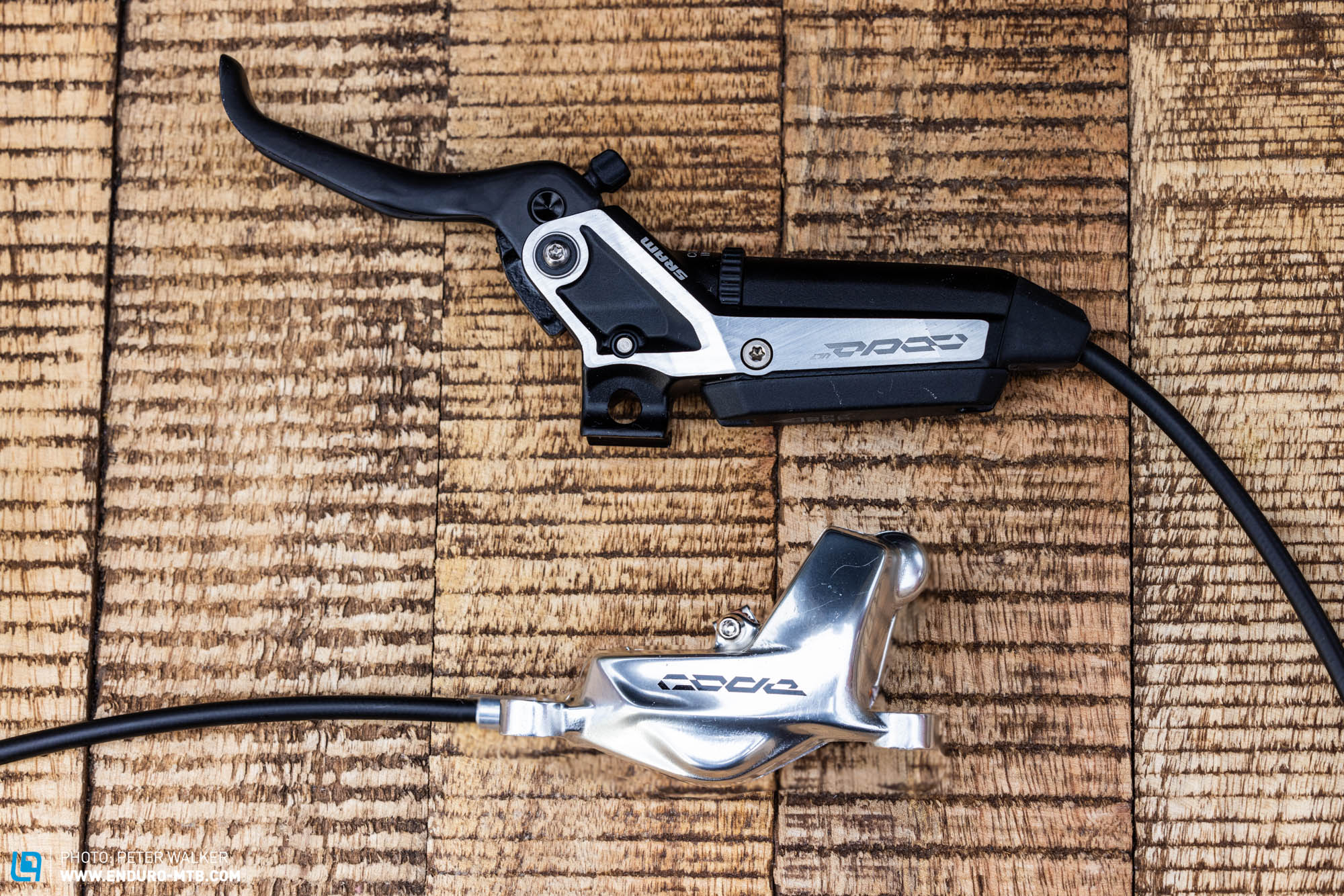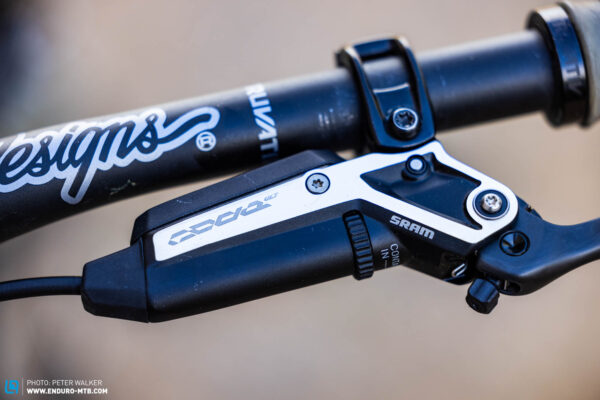The SRAM CODE Ultimate Stealth is the flagship model in the CODE range. After SRAM’s latest brake portfolio overhaul, however, it’s now aimed specifically at trail riding. Technically, it’s very similar to the previous CODE RSC, which secured victory in our last brake group test. How did the Stealth Ultimate fare in this year’s test?
Learn more about this comparison test: The best MTB disc brakes – 14 MTB brakes in comparison

SRAM CODEs have long been a popular OEM component for gravity oriented mountain bikes and until recently, they were the most powerful model in SRAM’s portfolio. With the new MAVEN, SRAM just launched a new flagship model for downhill and enduro use, while the CODE is now aimed primarily at trail riders. All CODE brakes employ four pistons and SRAM’s proprietary, two-piece handlebar clamp. This isn’t fixed to the lever unit and is a little finicky to use – it’s easy to drop the screw while disassembling the lever. However, the one-bolt system is relatively easy to use and attaches the lever unit securely to the handlebars. Moreover, SRAM’s matchmakers allow you to attach the shifter and dropper remote directly to the handlebar clamps, ensuring a tidy cockpit and excellent ergonomics. The new Stealth design positions the lever unit and brake hose even closer to the handlebars, which might look great, but also causes the cables to rattle loudly on the trail – annoying!
At € 640, the SRAM CODE Ultimate Stealth is the most expensive brake in the CODE family, and pretty much on the same level as Shimano’s top-tier XTR model. However, the new SRAM MAVEN Ultimate tops the price by another € 80. In purely technical terms, the CODE Ultimate is very similar to the old CODE RSC, meaning that it shares many of SRAM’s popular technologies. For example, it features tool free bite point and lever reach adjustments, as well as SRAM’s proprietary SwingLink technology, which is designed to minimise deadband and provide better modulation, allowing you to achieve the same braking power with less effort, reducing arm pump and fatigue. Furthermore, the Ultimate model relies on titanium hardware, which keeps the weight down to 594 grams. This is around 30 grams less than the bronze version, but still above average in this test.


To bleed the SRAM CODE Ultimate Stealth, you have to attach a syringe to the lever and one to the calliper. While the method per se is a bit fiddly, the clipped bleed port on the calliper prevents unnecessary spillage, ensuring a clean bleeding procedure. That’s a big plus, because DOT fluid is harmful to the skin and also ruins the paint and clothes.

SRAM Code Ultimate on test
In the lab, the SRAM CODE Ultimate Stealth proved slightly more powerful than the bronze variant, despite sharing similar technologies. However, with both models, braking performance improved significantly with our Sinter reference pad, which means that a simple pad upgrade can make a huge difference.
The lever reach adjustment is intuitive to use and allows you to fine tune the lever position to suit your needs and preferences, from very close to the bars to far out. On the trail, it provides the typical SRAM brake feeling with a soft bite point and good modulation. However, the SRAM CODE Ultimate Stealth can’t keep up with the rest of the test field in terms of sheer power, leading to fatigue and arm pump sooner than many of its competitors. In addition, the brake feel isn’t as snappy as with other brakes, like the Shimano and Hayes, while the actuation isn’t as smooth as with the Hope or Trickstuff, for example. Although both SRAM CODE models we tested delivered a similar performance in the lab, on the trail the Ultimate variant feels significantly more powerful.
Our conclusions about the SRAM CODE Ultimate Stealth
Not only does the CODE Ultimate Stealth offer SRAM’s popular look and excellent ergonomics, but also allows for a very clean cockpit thanks to the Stealth design, which positions the lever unit and cables close to the handlebars, if you can put up with the noise of your hoses rattling against the bars. On the trail, the CODE Ultimate combines a soft bite point and good modulation. However, in this test field it failed to impress and only offers minor advantages over the entry-level bronze model.
Tops
- Good compatibility with other SRAM components
- Good modulation
Flops
- Not very powerful
- Relatively high actuation resistance is a matter of taste
- Cables rattle against the handlebars
- Pricey
For more info, visit SRAM.com
Find the overview of this comparison test here: The best MTB disc brakes – 14 MTB brakes in comparison
All brakes in test:
Formula Cura 4 | Hayes Dominion T4 | Hope Tech 4 V4 | MAGURA MT5 Pro | MAGURA MT7 | Shimano SLX | Shimano XT | Shimano XTR | SRAM CODE Bronze Stealth | SRAM CODE Ultimate Stealth | SRAM MAVEN Ultimate | Trickstuff MAXIMA | TRP DH-R EVO | TRP Trail EVO |
Did you enjoy this article? If so, we would be stoked if you decide to support us with a monthly contribution. By becoming a supporter of ENDURO, you will help secure a sustainable future for high-quality mountain bike journalism. Click here to learn more.
Words: Simon Kohler Photos: Peter Walker









